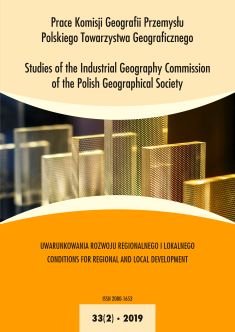Foreign Enterprises in the Siberian Economy
DOI:
https://doi.org/10.24917/20801653.332.9Keywords:
enterprises with foreign capital, foreign direct investment, legal entity, motives for investment, offshore companies, regional developmentAbstract
The purpose of the article is to identify the spatial character of foreign investment in Siberia where a considerable part of Russian export goods is produced for the markets of Europe and the Asia-Pacific region. A microeconomic approach was used, and the types and activities of enterprises with foreign capital were analysed. The main features were presented: the predominance of offshore investments, officially identified as foreign investment in the basic industries; increase in the share of investment into the mining industry and increasing dependence on China when moving east; high level of individual’s investment in services with fast capital turnover and minimal capital costs which forms a specific survival environment in the border areas with Mongolia and China. Three patterns of foreign investment in the Siberia are identified - western, central and eastern. The western pattern is characterised by a diversity of donor countries and investment in processing industries, the central one is based on the offshore capital in energy and semi-product industries, and in the eastern pattern investment into mining and logging prevails. The last type of investment is not receptive to innovations and new technologies, conserves and deepens the resource specialisation of industry for Asian markets of raw materials.
Downloads
Metrics
References
AEI (Agency of economic information) “Prime” (2017, 20 December). Retrieved from https:// bir.1prime.ru/
Avioutskii, V., Tensaout, M. (2016). Does politics matter? Partisan FDI in Central and Eastern Europe. Multinational business review, 24(4), 375–398.
Caputo, A., Pellegrini, M., Dabic, M., et al. (2016). Internationalisation of firms from Central and Eastern Europe. A systematic literature review. European business review, 28(6), 630–631.
CBR (2018, 10 December). Ostatky po subjectam Rossijskoj Federatsii v razreze instrumentov i stran-partnerov [Balances by regions of Russian Federation in the context of tools and partner countries]. Retrieved from http://www.cbr.ru/statistics/?ch=PAR_17218&prtid=svs#- CheckedItem
Choromides, C. (2018). The impact of the institutional framework quality on the ownership strategy.
Evidence from EU foreign direct investments in South and Central Eastern Europe. Journal of urban and regional analysis, 10(1), 25–60.
Demirbag, M., McGuinnness, M., Wood, G., Bayyurt N. (2015). Context, law and reinvestment decisions: Why the transitional periphery differs from other post-state socialist economies. International Business Review, 24, 955–965.
Domansky, B. (2000). Types of investment and locational preferences of European, American and Asian manufacturing companies in Poland. In: J. Parysek, T. Stryjakewicz (eds.). Polish economy in transition: spatial perspectives. Poznan: Bogucky Wydawnictwo Naukowe S.C., 29–39.
Dunning, J.H. (1994). Re-evaluating the benefits of foreign direct investment. Transnational corporations. United Nations Publications, 3(1), 23–52.
Glazyrina, I., Lavlinskii, S. (2017). Economic and ecological models in Russia’s mining sector. Regional research of Russia, 7(2), 180–187. doi: 10.1134/S2079970517020034
Pirozhnik, I. (2015). Foreign direct investment in transitional economies: the regional structure and peculiarities of development in Belarus. Prace Komisji Geografii Przemyslu Polskiego Towarzystwa Geograficznego [Studies of the Industrial Geography Commission of the Polish Geographical Society], 29(1), 113–125.
Tobolska, A. (2014). Choice of Locations by Foreign Investors: Motives for and Factors of Starting a Manufacturing Activity (the Example of Selected Factories in Poland). Prace Komisji Geografii Przemyslu Polskiego Towarzystwa Geograficznego [Studies of the Industrial Geography Commission of the Polish Geographical Society], 25, 230–250.
UNCTAD (2018, 10 December). Foreign direct investment: Inward and outward flows and stock, annual. Retrieved from http://unctadstat.unctad.org/wds/TableViewer/tableView.aspx
Downloads
Published
How to Cite
Issue
Section
License
Articles are published under the terms of the Creative Commons License (CC BY-ND 4.0; Attribution– NoDerivs).

